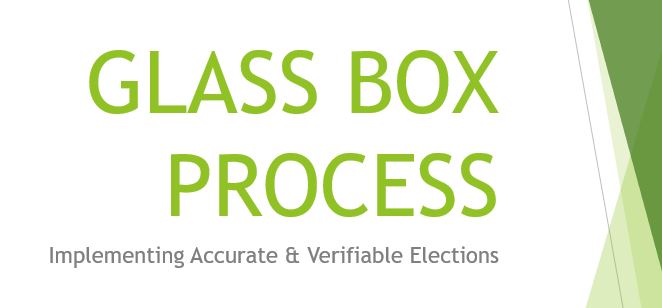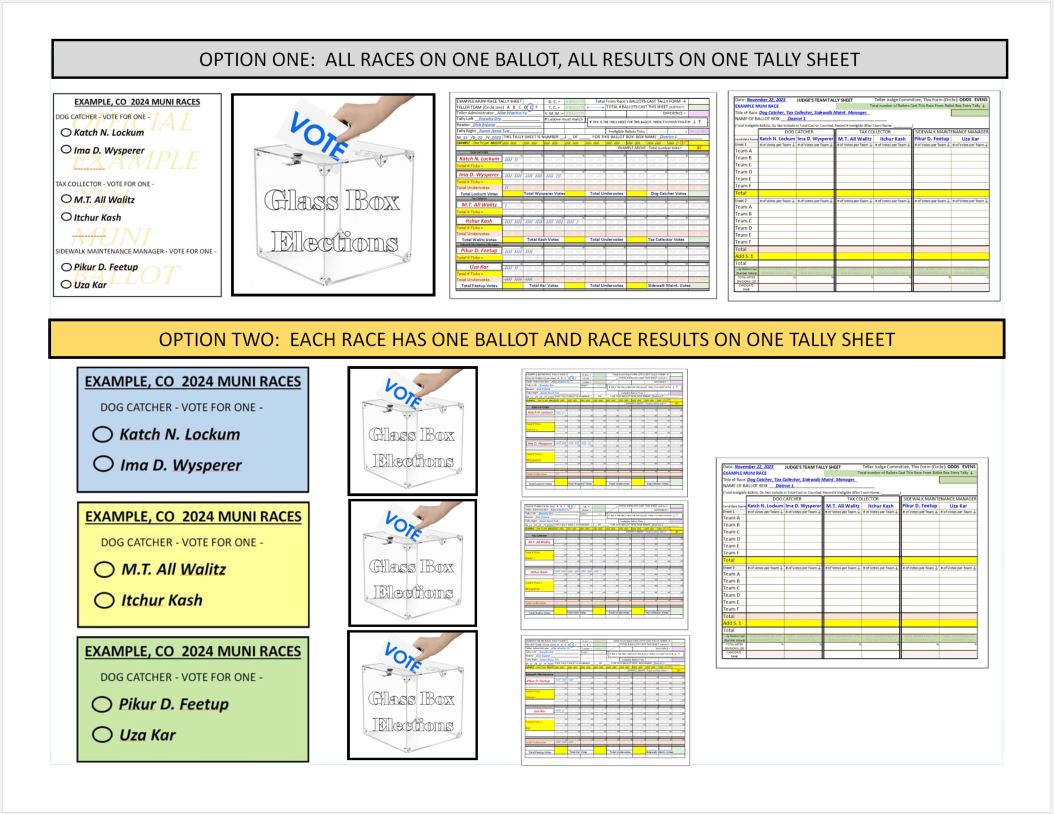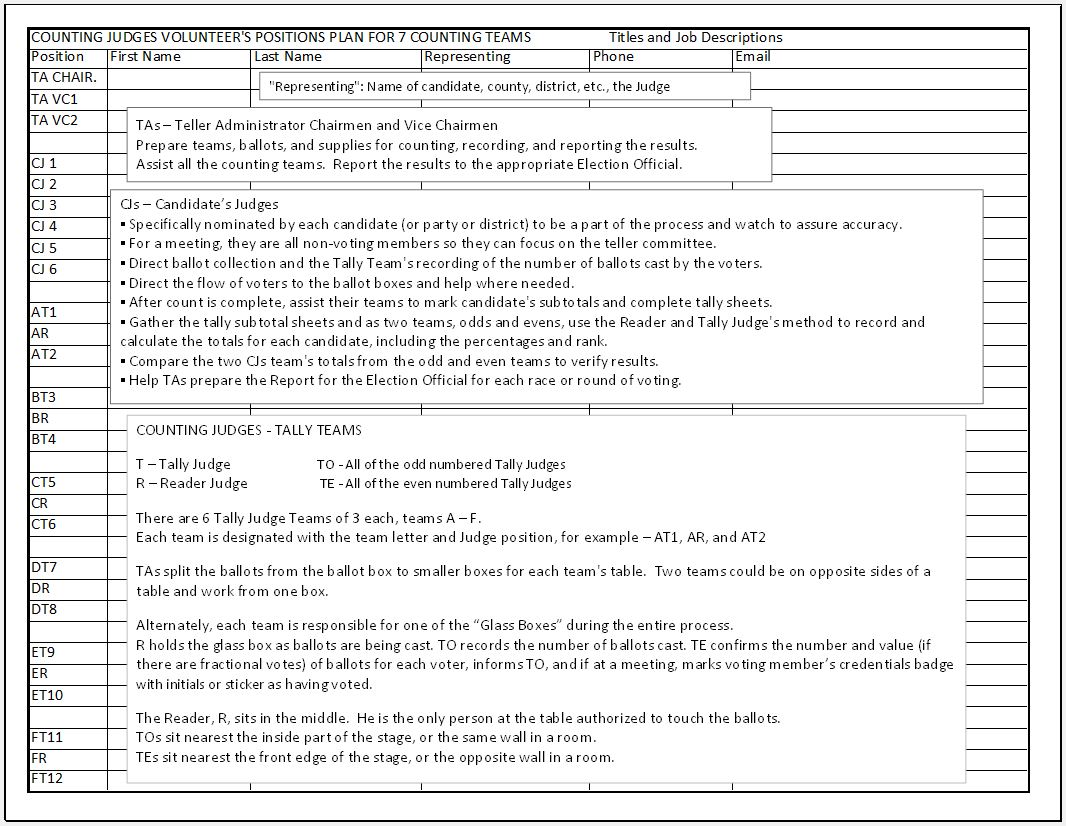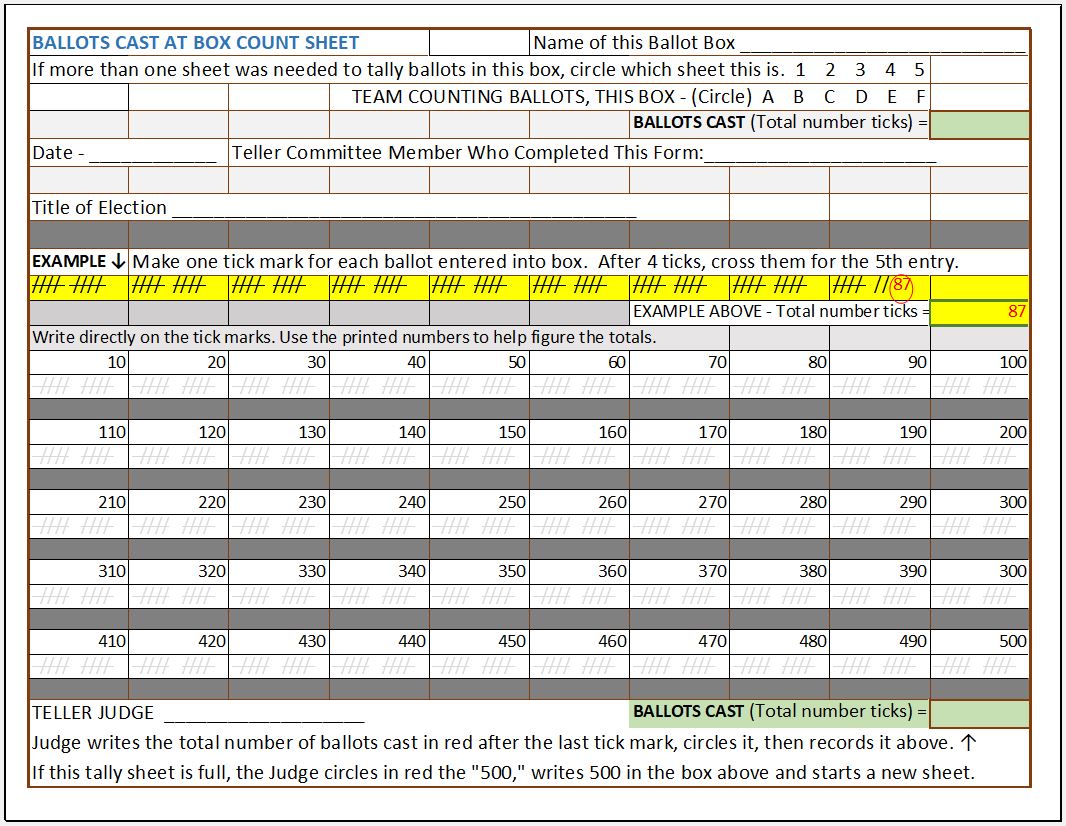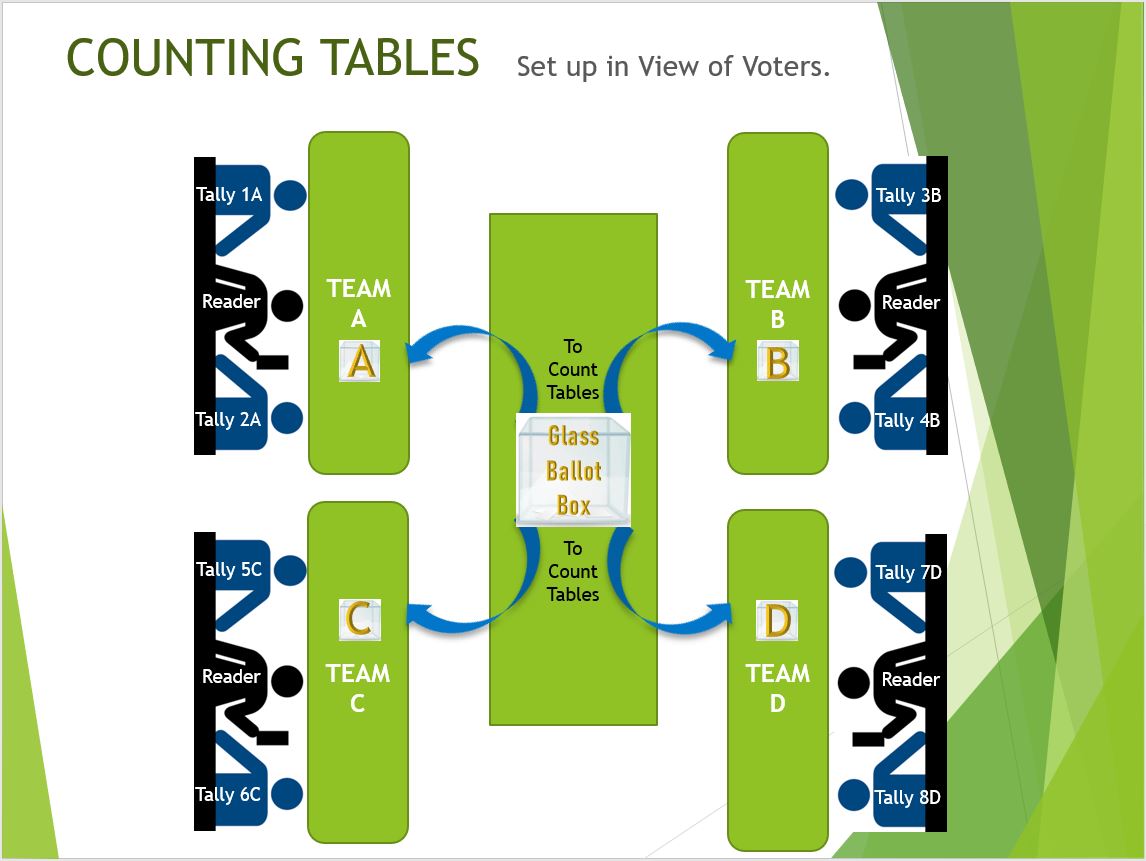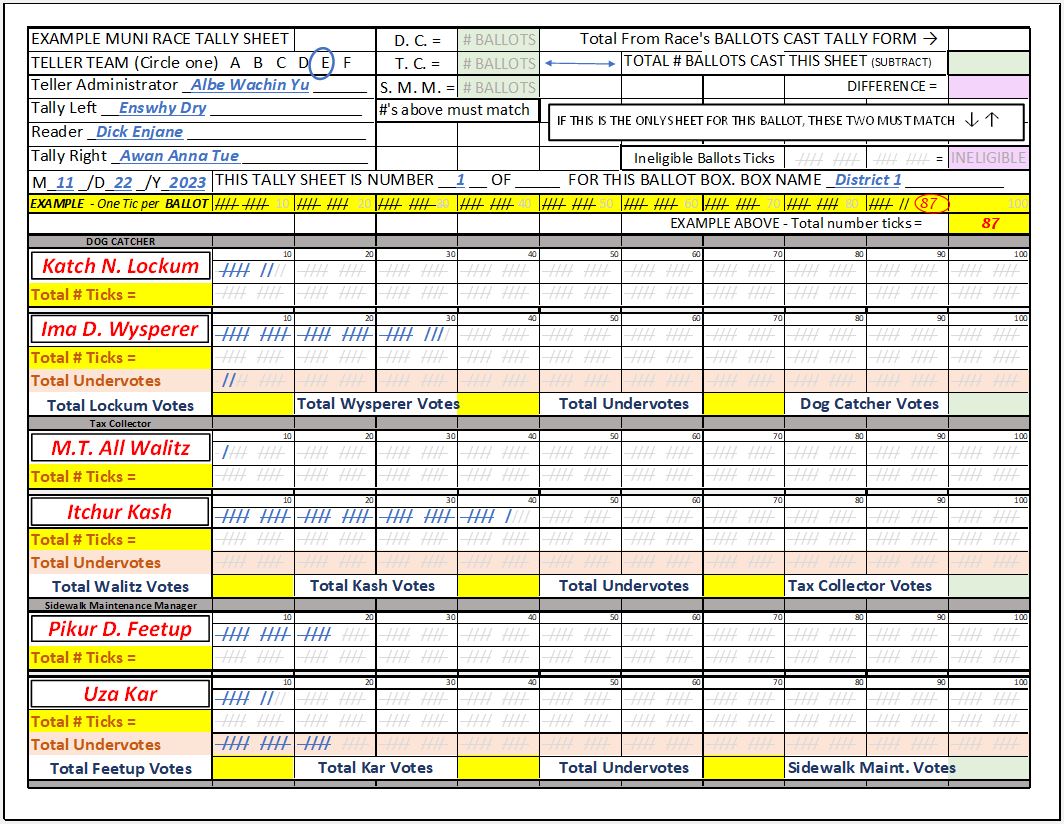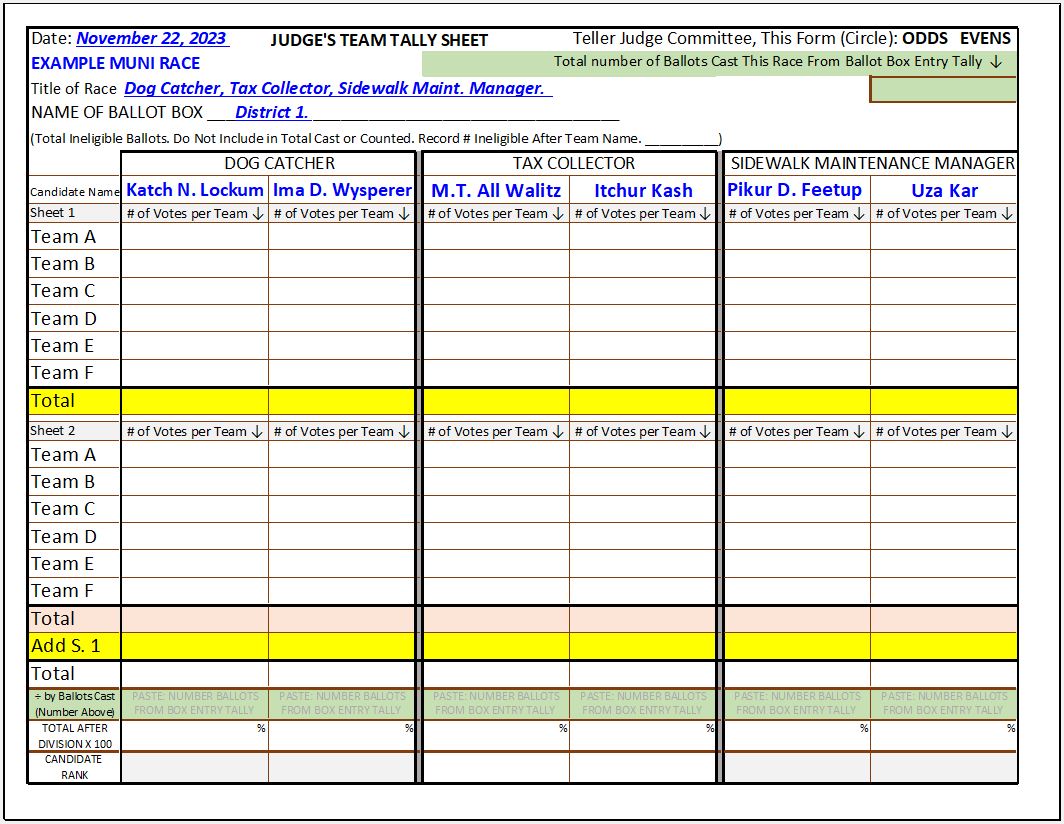September 5, 2023
by Peg Cage
The RNC passes a resolution calling for hand-counted elections! Read it here - RESOLUTION URGING A “RETURN TO EXCELLENCE” IN AMERICAN VOTING AND ELECTIONS🔗
CO Eliminate Voting Machines
"One of the pillars of the Colorado Plan (to restore election integrity) is the elimination of black box voting machines. Unless and until there exist (and they do not now exist) electronic voting machines that completely eliminate any risk of unauthorized use or access, and that allow complete transparency and voter verification of accuracy, voters must demand hand-count of paper ballots for vote tallying in elections. In Colorado, CRS 1-5-612 states that "(1) The governing body of any political subdivision may, upon consultation with the designated election official, adopt an electronic or electromechanical voting system, including any upgrade in hardware, firmware, or software, for use at the polling locations in the political subdivision. The system may be used for recording, counting, and tabulating votes at all elections held by the political subdivision," and CRS 30-11-103 states that "The powers of a county as a body politic and corporate shall be exercised by a board of county commissioners therefor." In other words, County Commissions can decide NOT to use electronic voting machines in their respective counties. This project is to enable Colorado citizens to persuade and compel our elected commissioners to reject electronic voting machines and cease their use in Colorado counties. This isn't Rocket Science; Americans once used ONLY hand-counting of paper ballots, and CRS 1-7-301 through 1-7-309 prescribes procedures for hand count of paper ballots in CO." (I believe the quote is from Cause of America.)
DISCLAIMER: While this method has been proven to work well and appears to conform to Colorado Statutes, it has not been approved by any legal authority which may be necessary prior to use in a municipality or other type of election. Colorado State Statute references are from https://leg.colorado.gov/sites/default/files/images/olls/crs2023-title-01.pdf.
Inclusion of legal references does not imply that the use of this method is a legal replacement for a machine-counted election or that it is approved by the State of Colorado. Additional forms and steps may be needed to provide a complete package for conducting the hand-count of an local or precinct election.
OVERVIEW:
This example is for conducting a local election in precinct or similar political division, or in a large meeting. Most of these forms can accommodate 500 votes. More forms could be added to accommodate more voters in a race.
ORGANIZERS:
Study law and this process, procure venues and supplies, design ballot style(s) and prepare for number of electors, train Election Judges, Counting Judges, and Candidate Judges.
ELECTION DAY:
- Opening - Election judges and people present verify ballot box is empty, box is locked.
- At Check in – Use eligible electors list to verify elector’s eligibility.
- Distribute ballot(s) to eligible elector.
- Elector votes their ballot(s) in secret then FOLDS it in half and takes it to the large clear plastic ballot box. (Fold is not needed for non-transparent ballot box)
- Election Judge confirms the elector's eligibility and add a tick mark on the Ballot Box Entry Count Form as their ballot is deposited.
- Counting Judges may start at 8 a.m. They trade an empty ballot box for the one being used, count the number of ballots in the box and compare the number to the Ballot Box Entry Count Form results, then record it on the Counting Judges’ form(s).
- Total ballots cast must be equal to or less than the total number of electors verified before counting begins.
- Ideally, counting tables are set up in view of the voters, but all “persons except election judges and watchers, shall be excluded from the place where the ballot counting is being held until the count has been completed.”
- Counting Judge Teams of three (3) (one Reader and two Tally Judges) are stationed at counting tables, with the ballot box in front of them.
- Reader takes one ballot, shows it to and reads it to the Tally Judges seated on his right and left.
- Tally Judges mark identical tally sheets, confirming frequently they have equal results.
- When a tally sheet is full, a new one is started, and all are stapled to the first.
- At the close of the polls, Candidates Judges (nominated by the candidates) gather the Tally Sheets and transfer the sheet results to the Judges’ Tallies Totals Sheet and calculate the final totals for that polling location.
DETAILED PROCESS:
Teller Administrators – Two or three people appointed as Election Judges to oversee the process at each location. They are responsible for communicating with the authorities for the organization under which the election is to be conducted and training the volunteer Counting Judges.
Design ballot style(s) and prepare enough ballots and ballot boxes for the expected number of qualified electors.
OPTION ONE: ALL RACES ON ONE BALLOT, ALL RESULTS ON ONE TALLY SHEET
Probably the best option for an election with six (6) or fewer candidates/issues. Longer paper could be used to accommodate more tally rows.
OPTION TWO: EACH RACE HAS ONE BALLOT AND RACE RESULTS ON ONE TALLY SHEET
A good choice for a large precinct/locality conducting several races. Rather than needing to create ballots and tally forms with combinations of races for every possible voter (designing many ballot styles), ballots and a ballot box could be separated into specific races. For example, using the voter’s precinct number as a guide, the election judge would hand electors a separate ballot for each race in which they are qualified to cast a ballot - their County, State House District, State Senate District, US Congressional and US Senate Districts, and Colorado State races. Each ballot would be cast in a separate ballot box for that specific race.
ORGANIZE VOLUNTEERS:
This is the plan for volunteers needed for about 500 voters. Plan for more teams or less to accommodate the size of the election.
ELECTION DAY:
At Check in –
(Election Judges make a self-affirmation as in 1-13.5-407, Oath of judges for local elections, below.)
Election Judges and people present verify ballot box is empty, box is locked.
An Election Judge uses the official, current voter list to verify elector’s eligibility by comparing their record to a government-issued photo ID. (See 1-7-110, below.)
The elector is given the ballot(s) for every race or issue for which they are eligible to vote.
The elector takes their ballot(s) to a private voting booth and marks it for their desired candidate or issue as per instructions.
The elector folds their ballot if the ballot box is clear. Not-folded ballots are ineligible. Two ballots folded together count as one ineligible ballot. Folding is not necessary if a secrecy envelope is provided, or the box isn’t clear. Elector places ballot into the ballot box in full view of the election judge.
Counting Teams Judge uses the Ballots Cast At Box Count Sheet to record the number of ballots placed into the Ballot Box.
The Counting Judges may start at 8 a.m. They trade an empty ballot box for the one being used, record the seal numbers, and take the ballots to the counting tables. (See CRS 1-7-301 and 1-7-305, below)
Counting Judge Teams of three (3) (one Reader and two Tally Judges) are stationed at counting tables, with the ballot box in front of them. Two Teams could sit across from each other at one table with the ballot box between them and both Readers working from the one box.
A Teller Administrator transfers the ballots from the large ballot box to clear medium containers which are distributed to the center of each counting table.
Alternately, each team could have a specific ballot box for which they are responsible. This works well at a large meeting where all ballots are being cast in a short time. The Reader holds the ballot box and watches over the voters and the process. Tally Odd checks the voter’s verification credentials and gives the voter a receipt of having cast a ballot. Tally Even makes a mark on the Ballots Cast at Box Count Sheet, directly on the pre-printed tick marks, for each of the ballots as they are cast into the Team’s clear ballot box.
Ideally, counting tables are set up in view of the voters, but “all persons except election judges and watchers, shall be excluded from the place where the ballot counting is being held until the count has been completed.” (CRS 1-7-307 (4))
The number of counting teams depends on the size of the election.
Election Watchers from each candidate/issue are welcome to watch the counting at arm’s length.
THE COUNTING PROCESS
- Ballots in the box are counted and count recorded on Tally Sheet. (See example below.)
- Total ballots cast must be equal to or less than the total number of members credentialed before counting begins. (See CRS 1-7-307, below)
- Counting Judge Team members work together and watch each other to insure a correct count.
- The center member, or “Reader,” takes one ballot, shows it to and reads it to the Tally Judges seated on his right and left.
- Both Tally Judges, using the pre-printed tick marks as a guide, mark their identical tally sheets with a tick indicating the voter’s choice or, if the voter did not vote in that race, the undervote.
- The tally sheets are divided into ten columns in each row. Each box accommodates ten tick marks, so a full row could have 100 marks, making it easy to total the votes for each candidate.
- Tally Judges frequently confirm they have equal results, saying “tally” each time they cross four ticks to mark the fifth vote.
- If the voter marked a choice for both candidates, or otherwise spoiled the ballot, the Judges record the ballot by marking in the “ineligible” ballot column and set it in a pile separate from the counted ballots.
- The Reader places the ballot into a smaller clear container. Ballots never touch the table and are only handled one at a time by the Reader.
- When a tally sheet is full, a new one is started, and all are stapled to the first.
When every ballot in the box has been counted, a Candidate’s Judge writes in red the number of ballots counted for each candidate at the end of the line of tick marks and circles it. (See EXAMPLE, highlighted in yellow on the form below.)
At the close of the polls, Counting Judges, preferably Candidates Judges (nominated to be on the Counting Judges’ team by the candidates) gather the Tally Sheets and transfer the sheet results to the Judges’ Tallies Totals Sheet and calculate the final totals for that polling location.
The total number of ballots counted (and ineligible) must match the total number of the ballots cast for that race.
The Candidates’ Judges figure the number of votes and the percentage of the vote received by each candidate. The Tally Administrator Chairman reports the totals to appropriate election official.
All forms can be edited to better fit the specific race.
SUPPLIES:
Official, current eligible voter list
Ballots designed for the specific election site.
Clear, locking ballot boxes – enough for the races and the Counting Judge’s teams to trade for full boxes
Privacy “booths” for voting
Numbered seals that must be cut off to remove
Red pens for Administrator Judges and Candidates’ Judges
unique colored pens for each tally team.
Election records and tally forms -
Chain of Custody form for ballots
Ballot Box Entry Count Form
Tally sheets
Totals sheets
Teller Administrator Chairman’s official reports forms
COLORADO ELECTION LAWS FOR HAND-COUNTED ELECTIONS
The selections from Title One copied below are from:
(https://leg.colorado.gov/sites/default/files/images/olls/crs2023-title-01.pdf)
1-3-101. Party affiliation required - residence. (1) (a) In order to vote at any precinct caucus, assembly, or convention of a political party, the elector must be a resident of the precinct for twenty-two days, must be registered to vote no later than twenty-two days before the caucus, assembly, or convention, and must be affiliated with the political party holding the caucus, assembly, or convention for at least twenty-two days as shown in the statewide voter registration system; except that any registered elector who has attained the age of eighteen years or who has become a naturalized citizen during the twenty-two days immediately preceding the meeting may vote at any caucus, assembly, or convention even though the elector has been affiliated with the political party for less than twenty-two days. If allowed by a political party's rules, a preregistrant may vote at any caucus, assembly, or convention if the preregistrant has been a resident of the precinct for twenty-two days before the caucus, assembly, or convention, and has been affiliated with the political party holding the caucus, assembly, or convention for at least twenty-two days as shown in the statewide voter registration system; except that a preregistrant who preregistered within the twenty-two days immediately preceding the meeting may vote at any caucus, assembly, or convention even though the preregistrant has been affiliated with the political party for less than twenty-two days.
(b) If an elector desires to vote at a precinct caucus but the elector's eligibility cannot be verified upon examination of the list of registered electors provided in accordance with subsection (3) of this section, the elector shall complete an affidavit attesting to the facts establishing the elector's eligibility. The secretary of state shall promulgate rules prescribing the form and content of the affidavit.
(2) Notwithstanding subsection (1) of this section and section 1-2-101 (1)(b), an elector who moves from the precinct where registered during the twenty-one days prior to any caucus may participate in and vote at the caucus in the precinct of the elector's former residence but shall not be eligible for election as a delegate or for nomination as a precinct committeeperson in the former precinct.
(3) (a) No later than twenty-one days prior to the date of the precinct caucus, or eighteen days prior to the date of the precinct caucus in a year in which a political party's precinct caucus is held on the first Saturday following the presidential primary election, the county clerk and recorder shall furnish without charge to each major political party in the county a list of the registered electors in the county who are affiliated with that political party. Notwithstanding Colorado Revised Statutes 2023 Page 88 of 552 Uncertified Printout section 1-2-227 (2), the list must include preregistrants whose information is otherwise confidential.
1-7-110. Preparing to vote in person.
(1) (a) When an elector appears in person to vote, a signature card containing the elector's name and residential address, as they appear in the statewide voter registration system created in section 1-2-301, shall be completed. Unless an elector is registering for the first time or updating the elector's voter registration information, the elector shall not be required to provide any information on the signature card in addition to the elector's name, residential address, and signature.
(b) Except as provided in subsection (4) of this section, an eligible elector desiring to vote in person shall show his or her identification as defined in section 1-1-104 (19.5), verify the information that appears on the signature card, sign the signature card, and give the signature Colorado Revised Statutes 2023 Page 244 of 552 Uncertified Printout card to one of the election judges. An eligible elector who is unable to write may request assistance from one of the election judges, who shall also sign the signature card and witness the eligible elector's mark. The signature card must provide:
I, ....................., affirm under penalty of perjury that I am a United States citizen and an eligible elector; I have been a Colorado resident for at least twenty-two days immediately before this election; I am registered to vote at my sole legal place of residence; I will be at least eighteen years of age on election day; and this is the only ballot I have voted in this election.
(2) If the eligible elector shows his or her identification within the meaning of section 1-1-104 (19.5) and the elector's name is found on the registration list or, where applicable, the property owner's list by the election judge in charge, the judge in charge of the pollbook or list shall enter the eligible elector's name, and the eligible elector shall be allowed to enter the immediate voting area. Besides the election officials, no more than four electors more than the number of voting booths shall be allowed within the immediate voting area at one time.
(2.5) If the elector's qualification to vote is established by the completion of an affidavit, and if the affidavit contains all of the information required in subsection (1) of this section, then the designated election official shall consider the affidavit the signature card.
(3) The election judges shall return the signed signature cards with other election materials to the designated election official.
(4) An eligible elector who is unable to produce identification may cast a provisional ballot in accordance with article 8.5 of this title.
(5) An eligible elector who does not reside within the county but wishes to vote at a polling location is entitled to receive a mail ballot or replacement mail ballot that contains the names of candidates for statewide federal and state offices and statewide ballot issues and ballot questions. The secretary of state shall certify the content of the ballot to the county clerk and recorder.
PART 3
PAPER BALLOTS
1-7-301. Judges open ballot box first. Immediately before proclamation is made of the opening of the polls, the election judges shall open the ballot box in the presence of those assembled and shall turn it upside down so as to empty it of anything that may be in it and then shall lock it securely. No ballot box shall be reopened until the time for counting the ballots therein.
1-7-305. Counting by counting judges.
(1) In precincts having counting judges, the receiving judges, at 8 a.m., or as soon thereafter as the counting judges request the ballot box, shall deliver to the counting judges the ballot box containing all ballots that have been cast up to that time, and the receiving judges shall then proceed to use the other ballot box furnished for voting. The receiving judges shall open, empty, and lock the alternate ballot box in the manner prescribed in section 1-7-301.
(2) When the counting judges have counted the votes in a ballot box, they shall return the empty ballot box to the receiving judges and exchange it for the box containing ballots cast since taking possession of the first ballot box. The judges shall continue to exchange ballot boxes in the same manner during the day until the polls are closed and shall continue counting until all ballots have been counted.
(3) When an exchange of ballot boxes is made as described in subsection (2) of this section, the receiving judges shall sign and furnish to the counting judges a statement showing the number of ballots that are to be found in each ballot box as indicated by the pollbooks. The counting judges shall then count ballots in the manner prescribed in section 1-7-307.
(4) The governing body may provide a separate room or building for the counting judges but, when ballot boxes are moved from one room or building to another, they shall be under the constant observation of at least one of the counting judges.
1-7-307. Method of counting paper ballots.
(1) The election judges shall first count the number of ballots in the box. If the ballots are found to exceed the number of names entered on each of the pollbooks, the election judges shall then examine the official endorsements. If, in the unanimous opinion of the judges, any of the ballots in excess of the number on the pollbooks are deemed not to bear the proper official endorsement, they shall be put into a separate pile and into a separate record, and a return of the votes in those ballots shall be made under the heading "excess ballots". When the ballots and the pollbooks agree, the judges shall proceed to count the votes.
(2) Each ballot shall be read and counted separately. Every name and all names of joint candidates separately marked as voted for on the ballot shall be read and an entry made on each of two accounting forms before any other ballot is counted. The entire number of ballots, excepting "excess ballots", shall be read, counted, and placed on the accounting forms in like manner. When all of the ballots, except "excess ballots", have been counted, the election judges shall post the votes from the accounting forms.
(3) When all the votes have been read and counted, the ballots shall be returned to the ballot box, the opening shall be carefully sealed, and the election judges shall place their initials on the seal. The cover shall then be locked and the ballot box delivered to the designated election official, as provided in section 1-7-701.
(4) All persons, except election judges and watchers, shall be excluded from the place where the ballot counting is being held until the count has been completed.
This section in italics is from https://www.sos.state.co.us/pubs/rule_making/CurrentRules/8CCR1505-1/Rule18.pdf:
Rule 18. Uniform Counting Standards for Paper Ballots
18.1 In any election where a multiple page printed ballot is used, a voter must vote and return all
pages of the ballot at the same time. Any voter who returns at least one page of a multiple page
printed ballot will be considered to have voted and the county clerk or designated election official
must count the votes on the submitted pages. The county clerk must not count votes on
additional pages returned at a later time. The county clerk must appropriately mark, set aside,
and preserve the ballots as election records in accordance with section 1-7-802, C.R.S.
18.2 Standards for hand counting paper ballots
18.2.1 In accordance with section 1-7-309, C.R.S., and Rule 18.5, judges counting ballots must
consider the intent of the voter.
18.2.2 If a race or ballot measure is overvoted, the judges must not count any vote for that race
or ballot measure.
18.2.3 If a race or ballot measure contains no markings by the voter, no tally will be made for
that race or ballot measure. But all other candidate races or ballot measures properly
marked by the voter on the ballot must be counted.
18.2.4 A ballot which has no markings for any candidate races or ballot measures must be
tallied as a blank ballot.
ARTICLE 8.3
Uniform Military and Overseas Voters Act
1-8.3-102. Definitions. In this article 8.3:
(1) "Ballot" means:
(a) A federal write-in absentee ballot;
(b) A ballot specifically prepared or distributed for use by a covered voter in accordance with this article; or
(c) A ballot cast by a covered voter in accordance with this article.
(2) "Covered voter" means:
(a) A uniformed-service voter defined in paragraph (a) of subsection (9) of this section who is a resident of this state but who is absent from this state by reason of active duty and who otherwise satisfies this state's voter eligibility requirements;
(b) An overseas voter who, before leaving the United States, was last eligible to vote in this state and, except for a state residency requirement, otherwise satisfies this state's voter eligibility requirements;
(c) An overseas voter who, before leaving the United States, would have been last eligible to vote in this state had the voter then been of voting age and, except for a state residency requirement, otherwise satisfies this state's voter eligibility requirements; or
(d) An overseas voter who was born outside the United States, is not described in paragraph (b) or (c) of this subsection (2), and, except for a state residency requirement, otherwise satisfies this state's voter eligibility requirements if the last place where a parent, legal guardian, spouse, or civil union partner of the voter was, or under this article would have been, eligible to vote before leaving the United States is within this state.
(3) "Dependent" means a spouse, civil union partner, or dependent of a covered voter described in subsection
(2) of this section who is a resident of this state but who is absent from the state by reason of the active duty or service of the covered voter.
(4) "Federal postcard application" means the application prescribed under section 101 (b)(2) of the federal "Uniformed and Overseas Citizens Absentee Voting Act", 52 U.S.C. sec. 20301 (b)(2).
(5) "Federal write-in absentee ballot" means the ballot described in section 103 of the federal "Uniformed and Overseas Citizens Absentee Voting Act", 52 U.S.C. sec. 20303.
(6) "Overseas voter" means a United States citizen who is outside the United States.
(7) "State" means a state of the United States, the District of Columbia, Puerto Rico, the United States Virgin Islands, or any territory or insular possession subject to the jurisdiction of the United States.
(8) "Uniformed service" means:
(a) Active and reserve components of the Army, Navy, Air Force, Marine Corps, Space Force, or Coast Guard of the United States;
(b) The merchant marine, the commissioned corps of the public health service, or the commissioned corps of the national oceanic and atmospheric administration of the United States; or
(c) The National Guard.
(9) "Uniformed-service voter" means an individual who is qualified to vote and is:
(a) A member of the active or reserve components of the Army, Navy, Air Force, Marine Corps, Space Force, or Coast Guard of the United States who is on active duty;
(b) A member of the merchant marine, the commissioned corps of the public health service, or the commissioned corps of the national oceanic and atmospheric administration of the United States;
(c) A member on activated status of the National Guard; or
(d) A spouse, civil union partner, or dependent of a member referred to in this subsection (9).
(10) "United States", used in the territorial sense, means the several states, the District of Columbia, Puerto Rico, the United States Virgin Islands, and any territory or insular possession subject to the jurisdiction of the United States.
1-8.3-103. Elections covered.
(1) The voting procedures in this article apply to:
(a) A general, congressional vacancy, or primary election for federal office;
(b) A general, recall, or primary election for statewide or state legislative office or state ballot measure;
(c) Any other election coordinated by the county clerk and recorder; and
(d) An election conducted under article 13.5 of this title.
PART 3
NOMINATIONS
1-13.5-301. Eligibility for office - prohibitions - exceptions - challenges.
(1) (a) No person except an eligible elector who is at least eighteen years of age, unless another age is required by law, is eligible to hold any office in this state. No person is eligible to be a candidate for office unless that person fully meets the qualifications of that office as stated in the constitution and statutes of this state on or before the date the person is nominated to the office. The designated election official shall not certify the name of any candidate who fails to swear or affirm under oath that he or she fully meets the qualifications as of the date of nomination or who is unable to provide proof that he or she meets any requirements of the office relating to registration, residence, or property ownership.
(b) The information found on the person's voter registration record is admissible as prima facie evidence of compliance with the registration and residence requirements of this section. The information found in the property owners list is admissible as prima facie evidence of compliance with property ownership requirements.
(2) Except as otherwise provided in this subsection (2), no person is eligible to be a candidate for more than one office in the same local government at one time. This subsection (2) does not:
(a) Apply to memberships on different special district or business improvement district boards; or
(b) Prohibit a candidate or elected official of any political subdivision from being a candidate or member of the board of directors of any special district, business improvement district, or districts in which he or she is an eligible elector, unless otherwise prohibited by law.
(3) The qualification of any candidate may be challenged by an eligible elector of the local government within five days after the date that the designated election official certifies the candidate to the ballot. The challenge shall be made by verified petition setting forth the facts alleged concerning the qualification of the candidate and shall be filed in the district court in the county in which the local government is located. The hearing on the qualification of the candidate must be held not less than five nor more than ten days after the date the designated election official's statement is issued that certifies the candidate to the ballot. The court shall hear the testimony and other evidence and, within forty-eight hours after the close of the hearing, determine whether the candidate meets the qualifications for the office for which the candidate has declared. Part 1 of article 17 of title 13, C.R.S., regarding frivolous, groundless, or vexatious actions, applies to this section.
1-13.5-407. Oath of judges.
Before any votes are taken at any local government election, the election judges shall make a self-affirmation substantially in the following form: I, ...., do solemnly swear (or affirm) that I am a citizen of the United States and the state of Colorado; that I am a registered elector in Colorado; that I will perform the duties of election judge according to law and the best of my ability; that I will studiously endeavor to prevent fraud, deceit, and abuse in conducting the same; that I will not try to ascertain how any elector voted, nor will I disclose how any elector voted if, in the discharge of my duties as judge, such knowledge shall come to me, unless called upon to disclose the same before some court; and that I will not disclose the result of the votes until the polls have closed.
